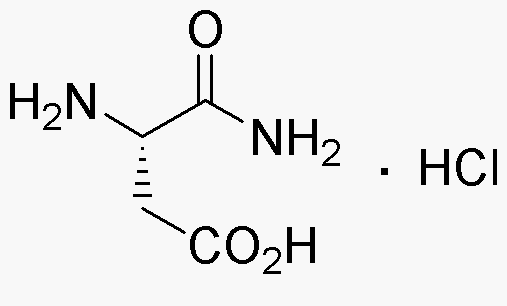L-Aspartic acid a-amide hydrochloride is widely utilized in research focused on:
- Pharmaceutical Development: This compound is used in the synthesis of various pharmaceuticals, particularly in the development of drugs targeting neurological disorders due to its role in neurotransmitter function.
- Amino Acid Supplementation: It serves as a dietary supplement for athletes and bodybuilders, promoting muscle recovery and enhancing performance by supporting energy production.
- Biochemical Research: Researchers employ it in studies related to protein synthesis and metabolism, helping to understand cellular processes and enzyme functions.
- Food Industry: It is utilized as a flavor enhancer and nutritional additive in food products, contributing to the amino acid profile and improving taste.
- Cosmetic Formulations: The compound is incorporated into skincare products for its moisturizing properties and potential to improve skin elasticity, appealing to the beauty industry.
General Information
Properties
Safety and Regulations
Applications
L-Aspartic acid a-amide hydrochloride is widely utilized in research focused on:
- Pharmaceutical Development: This compound is used in the synthesis of various pharmaceuticals, particularly in the development of drugs targeting neurological disorders due to its role in neurotransmitter function.
- Amino Acid Supplementation: It serves as a dietary supplement for athletes and bodybuilders, promoting muscle recovery and enhancing performance by supporting energy production.
- Biochemical Research: Researchers employ it in studies related to protein synthesis and metabolism, helping to understand cellular processes and enzyme functions.
- Food Industry: It is utilized as a flavor enhancer and nutritional additive in food products, contributing to the amino acid profile and improving taste.
- Cosmetic Formulations: The compound is incorporated into skincare products for its moisturizing properties and potential to improve skin elasticity, appealing to the beauty industry.
Documents
Safety Data Sheets (SDS)
The SDS provides comprehensive safety information on handling, storage, and disposal of the product.
Product Specification (PS)
The PS provides a comprehensive breakdown of the product’s properties, including chemical composition, physical state, purity, and storage requirements. It also details acceptable quality ranges and the product's intended applications.
Certificates of Analysis (COA)
Search for Certificates of Analysis (COA) by entering the products Lot Number. Lot and Batch Numbers can be found on a product’s label following the words ‘Lot’ or ‘Batch’.
*Catalog Number
*Lot Number
Certificates Of Origin (COO)
This COO confirms the country where the product was manufactured, and also details the materials and components used in it and whether it is derived from natural, synthetic, or other specific sources. This certificate may be required for customs, trade, and regulatory compliance.
*Catalog Number
*Lot Number
Safety Data Sheets (SDS)
The SDS provides comprehensive safety information on handling, storage, and disposal of the product.
DownloadProduct Specification (PS)
The PS provides a comprehensive breakdown of the product’s properties, including chemical composition, physical state, purity, and storage requirements. It also details acceptable quality ranges and the product's intended applications.
DownloadCertificates of Analysis (COA)
Search for Certificates of Analysis (COA) by entering the products Lot Number. Lot and Batch Numbers can be found on a product’s label following the words ‘Lot’ or ‘Batch’.
*Catalog Number
*Lot Number
Certificates Of Origin (COO)
This COO confirms the country where the product was manufactured, and also details the materials and components used in it and whether it is derived from natural, synthetic, or other specific sources. This certificate may be required for customs, trade, and regulatory compliance.


